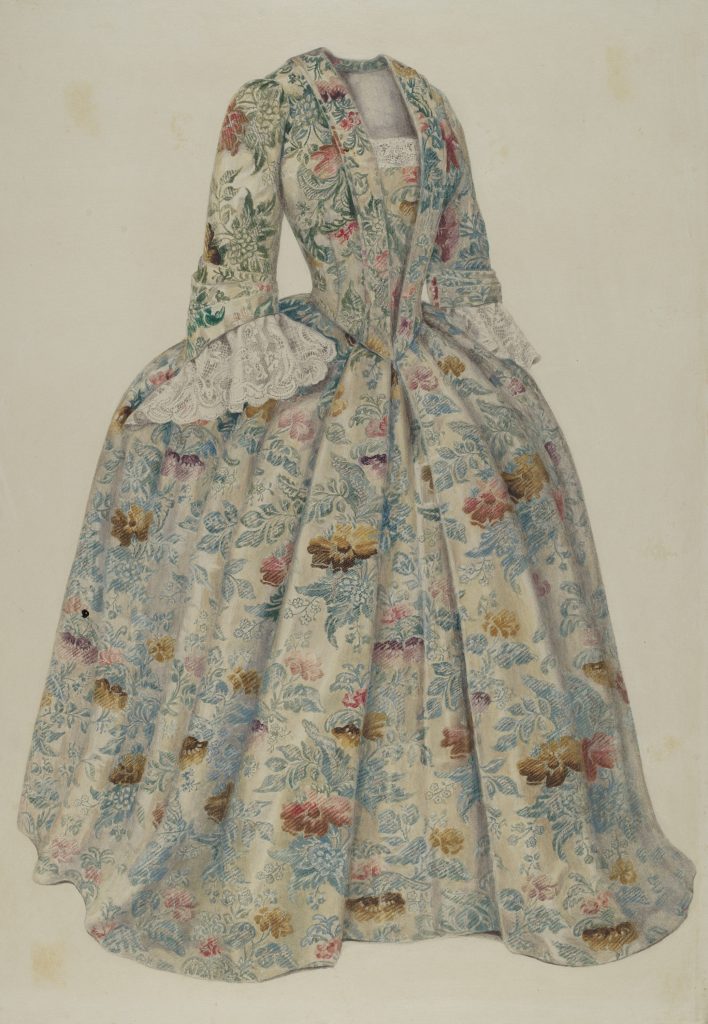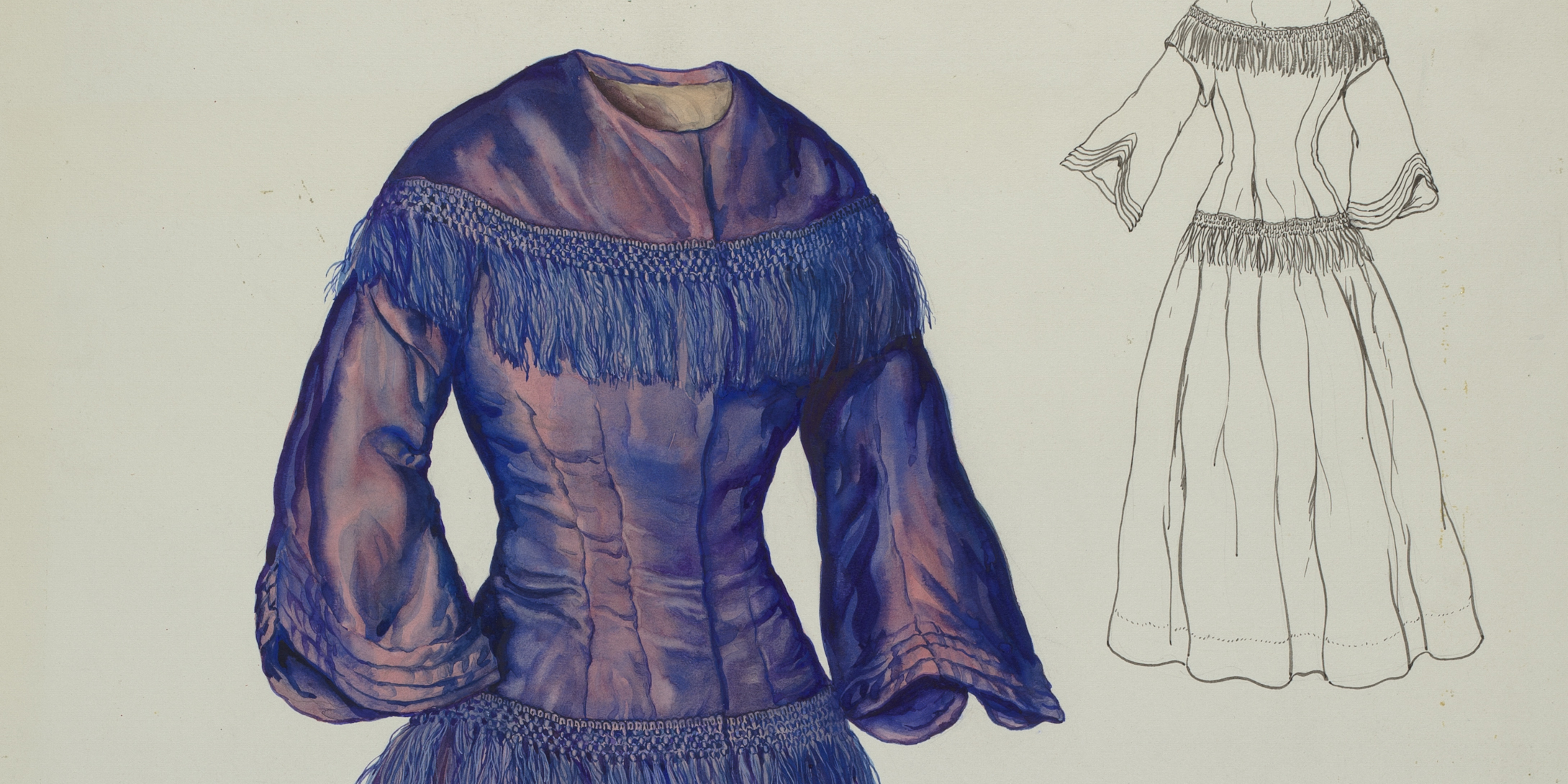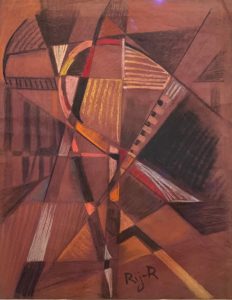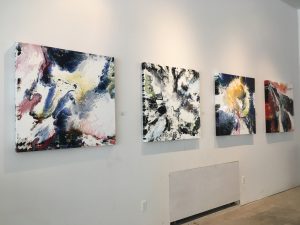The National Gallery of Art’s online exhibit Fashioning a Nation is a memorial to the close relationship between two essential facets of culture: history and fashion. Each sketch connects the present to a literal and figurative thread of the past. Every artist joins to construct carefully a world of exquisitely tailored styles that proliferated during America’s early ages, from the 1700s to 1800s.
The National Gallery has partnered with Google Arts and Culture to present various artists’ detailed renderings on a scrollable webpage. Small blurbs accompany each drawing to supply supplementary information. The full length of the article also includes magnified images of the sketches to show viewers the minute details of the sketches.
Fashion represents the life of its wearers: Form and function match the desires and needs of a culture at different points in time. The gallery presents styles from the 1700s to the late 1800s; the chronological sequence of images subtly explains what types of dress were typically expected as the colonial era progressed and passed into the time of the industrial revolution. Although the sketches come from the 1930s and 40s, the artists all captured delicately and completely the clothing from another time. Even more admirable is the abundance of work from not just men, but women as well.

National Gallery of Art Dress, Julie C. Brush, 1935/1942, From the collection of: National Gallery of Art, Washington DCNational Gallery of Art
A striking, floral-patterned dress immediately ensnares the viewer’s attention with its delicate lace-trimmed sleeves, structured blazer-like top, and wide, flared skirt. A closer look at Dress by Julie C. Brush allows the pleating to take center, literally. The crisp lines of the dress descend from its structured upper construction into a tight, small waist. A multitude of dyed hues are spread across the dress, completing its look for a perfectly colonial, Hamilton-esque design.
This patterning is reminiscent of French fashions, which had a significant influence on American style. When put in context of France’s assistance during the Revolutionary War and its subsequent diplomatic relationship with the United States, the dress seems more than just an article of clothing. Despite an ambiguous date of production in either 1935 or 1942, the gown preserves history within its folds.
The quite similar Dress by Melita Hofmann follows immediately after, but the juxtaposition of the two gives viewers an opportunity to examine the small differences between them. Hofmann’s rich-looking gold and cream dress, created in the same year range as that of Brush’s, is equally elaborately patterned and includes a new element: a quilted petticoat underneath. Even though other material lays over it, the zoomed-in image reveals the petticoat’s attentive stitching and designs.
The wonder of the dresses does not end there: Fashioning a Nation features necessary accessories to the outfits as well. The 1939 sketch Woman’s Shoes by Marie Alain is a petite companion; the delicate shoes continue the theme of floral patterns with their green and brown designs. The curved heel gives an interesting flair to the shoe (not unlike recent trends of Prada heels with flames); however, curiously enough, the shoe itself was not intended for walking. Instead, separate soles had to be attached for walking purposes. The 1935/1942 Poke Bonnet by Irene Lawson presents a stately hat with a scarf-like item winding around atop the brim. The bonnet has an unidentified assortment of berries and flowers that add a flash of color to the neutral-toned accessory. The hat itself also served a social function, a clear example of society and fashion woven together: The hat shielded the wearer’s face from view, reinforcing the ideal of demureness and propriety expected from women.

National Gallery of Art Silk Vest, Florence Earl, c. 1938, From the collection of: National Gallery of Art, Washington DCNational Gallery of Art
Fortunately, the gallery does not just focus on women’s fashions, but contains examples of men’s and children’s clothing. Man’s Waistcoat by Ruggiero Pierotti teaches viewers about the simple yet thoughtfully structured coats that colonial men wore. Meticulous embroidery appeared in men’s fashion, and so did flared waists and floral patterns, as in Silk Vest by Florence Earl. Gentle blues, greens, and purples intermingle across the vest, which also features dainty blue flowers splashed across its upper section. The designs on the miniature skirt to the vest only get more impressive; tiny flowers overlap each other, and the multicolored petals add lovely complementary colors to the pale blue of the fabric.
While the colors are sometimes more muted and less extravagant in men’s wardrobes, as exhibited by Pierotti’s piece and Dorothy Dwin’s Man’s Shoe, the presence of care and elegant style is obvious. Each sketch manages not only to inform the viewers of the structure and style of garments, but also implies another story behind how an item was constructed. The proximity to the item, which the website grants through zooming and its closeup images, allows the viewer to see the clothes as if the outfits were actually in front of them, but of course, there are notable differences. The connection one feels to an art exhibit is not as palpable here, yet Google Arts and Culture’s high-quality images present a good secondary experience. Through this in-depth imaging, the viewer does almost feel like they are about to dress themselves in the exact pieces.
One can even imagine dressing a child in the frilly outfit of Boy’s Suit by Nancy Crimi, whose sketch creates a mockup of what a late 1800s century toddler would wear. The miniature scarlet coat paired with dark emerald trousers comprise an outfit not unlike that of a little doll. The subsequent sketches and commentary reveal the direct reflection of women’s clothing visible in little girl’s clothing, bringing to mind questions about the expectations placed upon women’s behavior starting from a young age.
The gallery traces the trends of the industrial age as well, in which an increasing number of machine-produced items allowed for more complexity and efficiency when making clothing. Women’s clothing acquired more detailing and fine materials, which also resulted from the trade relationships America cultivated. With time came more societal changes as well. Though made from a heavy wool material and paired with a cape, Daniel Marshack’s Women’s Gym Suit, along with a bright red and white pleated dress by Henry De Wolfe, exemplifies the changes that women experienced, such as an increase in physical activity and advocacy for women’s rights. Changing attitudes were reflected in fashions, resulting in simpler, more gentle silhouettes for women’s dresses and a variety of wear for women’s lives.
Fashioning a Nation is a bit of a lengthy article to scroll through, which results in quite a drastic change from the environment of a gallery, but it is well worth the online site visit. The exhibit smoothly presents two ideas: Fashion catalogs history, and a culture both forms and can inform through the medium of fashion. America may have changed vastly since its beginnings in the 18th century, yet we are still tied by a shared culture and the subtle elements and trends of fashion that these sketches preserve on paper. The sketches of Fashioning a Nation allow current viewers to connect to the country’s initial ways of life and its formative material culture that continue to affect Americans even in the present day.






[…] Source link […]